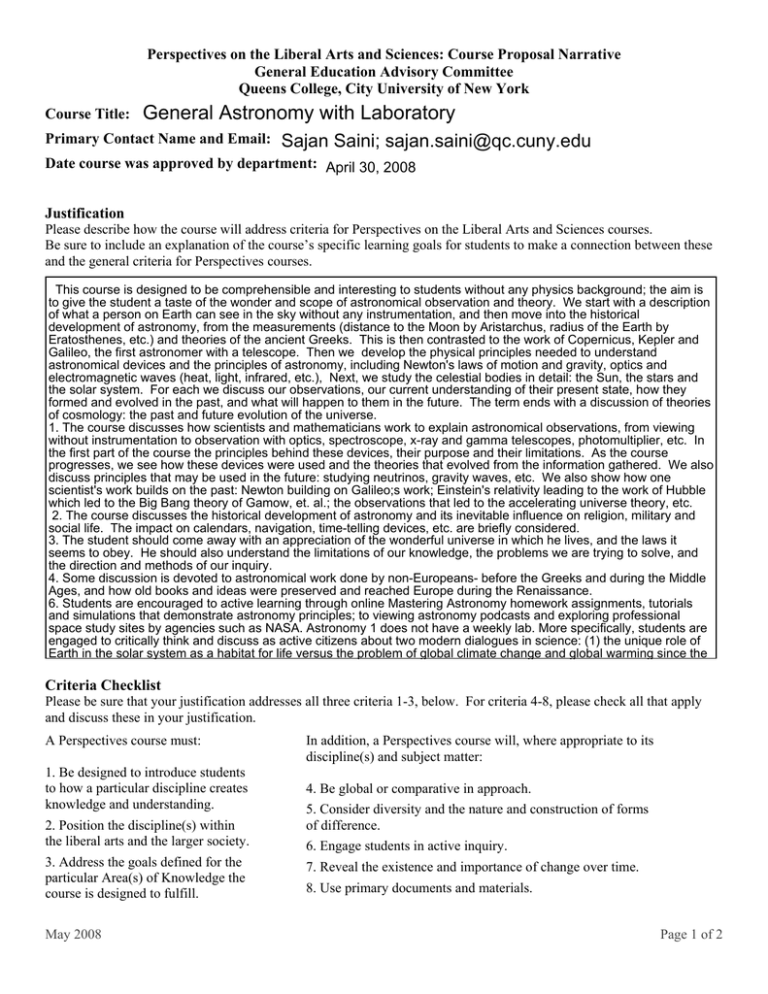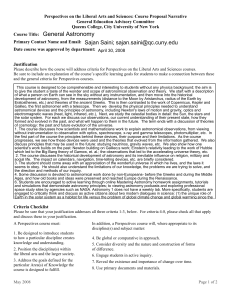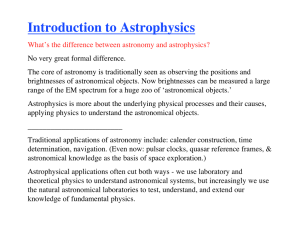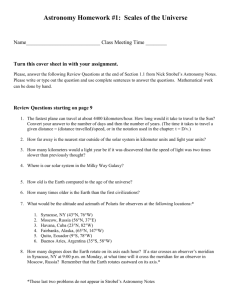Perspectives on the Liberal Arts and Sciences: Course Proposal Narrative
advertisement

Perspectives on the Liberal Arts and Sciences: Course Proposal Narrative General Education Advisory Committee Queens College, City University of New York Course Title: General Astronomy with Laboratory Primary Contact Name and Email: Sajan Saini; sajan.saini@qc.cuny.edu Date course was approved by department: April 30, 2008 Justification Please describe how the course will address criteria for Perspectives on the Liberal Arts and Sciences courses. Be sure to include an explanation of the course’s specific learning goals for students to make a connection between these and the general criteria for Perspectives courses. This course is designed to be comprehensible and interesting to students without any physics background; the aim is to give the student a taste of the wonder and scope of astronomical observation and theory. We start with a description of what a person on Earth can see in the sky without any instrumentation, and then move into the historical development of astronomy, from the measurements (distance to the Moon by Aristarchus, radius of the Earth by Eratosthenes, etc.) and theories of the ancient Greeks. This is then contrasted to the work of Copernicus, Kepler and Galileo, the first astronomer with a telescope. Then we develop the physical principles needed to understand astronomical devices and the principles of astronomy, including Newton's laws of motion and gravity, optics and electromagnetic waves (heat, light, infrared, etc.), Next, we study the celestial bodies in detail: the Sun, the stars and the solar system. For each we discuss our observations, our current understanding of their present state, how they formed and evolved in the past, and what will happen to them in the future. The term ends with a discussion of theories of cosmology: the past and future evolution of the universe. 1. The course discusses how scientists and mathematicians work to explain astronomical observations, from viewing without instrumentation to observation with optics, spectroscope, x-ray and gamma telescopes, photomultiplier, etc. In the first part of the course the principles behind these devices, their purpose and their limitations. As the course progresses, we see how these devices were used and the theories that evolved from the information gathered. We also discuss principles that may be used in the future: studying neutrinos, gravity waves, etc. We also show how one scientist's work builds on the past: Newton building on Galileo;s work; Einstein's relativity leading to the work of Hubble which led to the Big Bang theory of Gamow, et. al.; the observations that led to the accelerating universe theory, etc. 2. The course discusses the historical development of astronomy and its inevitable influence on religion, military and social life. The impact on calendars, navigation, time-telling devices, etc. are briefly considered. 3. The student should come away with an appreciation of the wonderful universe in which he lives, and the laws it seems to obey. He should also understand the limitations of our knowledge, the problems we are trying to solve, and the direction and methods of our inquiry. 4. Some discussion is devoted to astronomical work done by non-Europeans- before the Greeks and during the Middle Ages, and how old books and ideas were preserved and reached Europe during the Renaissance. 6. Students are encouraged to active learning through online Mastering Astronomy homework assignments, tutorials and simulations that demonstrate astronomy principles; to viewing astronomy podcasts and exploring professional space study sites by agencies such as NASA. Astronomy 1 does not have a weekly lab. More specifically, students are engaged to critically think and discuss as active citizens about two modern dialogues in science: (1) the unique role of Earth in the solar system as a habitat for life versus the problem of global climate change and global warming since the industrial revolution; (2) how the birth of nuclear science has led to our understanding of the Sun's energy output, the development of nuclear weapons, and current debates in the news over the control and employment of nuclear Criteria weapons Checklist and energy sources, respectively. Please be sure thatimportant your justification all three criteria For criteria 4-8, Stress please is check all on thatthe apply 7. There are two areas of addresses change: changing theories1-3, andbelow. the evolving universe. placed growth of ideas, howjustification. one theory builds on the next. Also: until relatively recently (the beginning of the nineteenth and discuss theseand in your century), the prevalent view among scientists was that the sky is permanent and unchanging. Today we can study and Amap Perspectives course addition, time a Perspectives courseAwill, where appropriate its evolution of starsmust: and planets, despite theInenormous frame involved. large percentage of thetocourse is spent discussing these changes and the principles behind them. discipline(s) and subject matter: 1. Be designed to introduce students to how a particular discipline creates knowledge and understanding. 2. Position the discipline(s) within the liberal arts and the larger society. 3. Address the goals defined for the particular Area(s) of Knowledge the course is designed to fulfill. May 2008 4. Be global or comparative in approach. 5. Consider diversity and the nature and construction of forms of difference. 6. Engage students in active inquiry. 7. Reveal the existence and importance of change over time. 8. Use primary documents and materials. Page 1 of 2 Course Materials, Assignments, and Activities Please provide an annotated list of course readings and descriptions of major assignments or exams for the course, as well as distinctive student activities that will engage students in working toward the course goals discussed in the course description and/or justification. Please include the author and title for each reading or text, along with a short description providing information about how the reading will contribute to course goals. Every instructor teaching this course uses the textbook The Essential Cosmic Perspective by Bennett, Donahue, Schneider and Voit. The course covers most of the material in this book, which has many beautiful illustrations and photographs to accompany the text. There is a mid-term exam and a final exam. Each instructor uses his own exam; question types include multiple choice, fill-in, matching, and questions requiring a sentence or two of explanation. This course includes a two hour laboratory exercise which meets 15 times during the term. The labs have been completely redesigned by the course supervisor, Dr. Cadieu, new equipment has been purchased, and computers have been installed for the students to use. The labs are designed to let the student explore the material discussed in lecture. They gain new knowledge, insight into complex concepts, and a visual "feel" for the material. The labs contain a combination of physical equipment to allow students direct contact with telescopes and other astronomical equipment, as well as computer-based labs that simulate measurements made by tools normally too expensive to obtain/access in an introductory laboratory. Homework assignments depend on the instructor. Many use an on-line homework system called Mastering Astronomy; the assignment can be created by selecting questions from a large bank, and the student does the work on his or her home computer. Some of the instructors post materials on CUNY Blackboard: some post course notes (with pictures and photographs) from Microsoft Word, some post Microsoft Powerpoint slides in class. This facilitates note taking, and allows the student to spend more time listening and less time taking notes. Some of the instructors also use "clickers" to get immediate feedback from the students. Questions are displayed or asked in class, and the students "click" their response. Assessment Perspectives courses must be recertified every five years, and we are seeking ideas for how to best carry out this assessment. What forms of evidence that the course is meeting its goals as a Perspectives course would be appropriate to collect for this course during the next five years? How would you prefer assessment to be conducted? How might evidence of effective teaching and student learning be collected and evaluated? Student evaluation forms provide a pragmatic sampling of student feedback for courses. For several years, the Physics Department has carried out its own assessment via an on-line evaluation, and we believe this to be highly effective. Near the end of each term, the evaluation forms are distributed and students are requested to log into a secure Department site and on-line evaluate the teacher(s) of each physics course. Final exams are saved and optionally used as an assessment as well. Some faculty also recommend the conducting of student interviews for comprehensive feedback. Administration What process will your department develop to oversee this course, suggest and approve changes, and conduct assessment? Who will be in charge of this process? Also indicate whether the course will be primarily taught by full-time or adjunct faculty, or by a combination of the two types of instructor. This course is taught by full professors as well as select adjunct faculty; the percentages depend on the particular term. (For example, this term there are two Astronomy 1 courses: one is taught by a full professor, and one by an adjunct.) In the Physics department, each course has a course supervisor who can make, receive and coordinate suggestions for changes in the course. When a new teacher is assigned to a course, a meeting is arranged with the course supervisor to discuss the curriculum, textbook, etc. We have also duplicated notes and assignments to help the new teacher develope his course. In the future, this discussion will include PLAS goals and options for new methods of meeting the PLAS criteria. May 2008 Page 2 of 2





